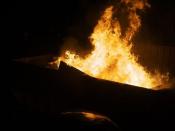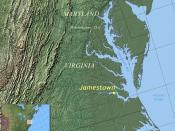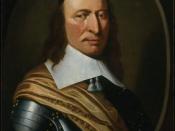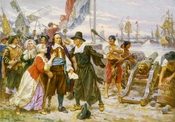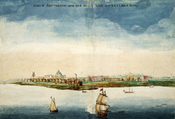Principles of Fire BehaviorNovember 02, 2009AbstractSince the dawn of time, man has had the greatest need for, respect for, and fear of the power of fire. Many primal tribes originally believed in a god of fire and routinely held rituals for the spirits, not only conducting religious ceremonies and presenting sacrifices, but creating complete social and behavioral norms all surrounding the mysterious marvel of fire. As time passed, mankind attempted to harness the intensity of fire and control the unforeseeable outcomes. Unfortunately, as the population increased, so did the potential for the unexpected ramifications of this necessary, yet sometimes violent, tool.
Evolution of the United States Fire Service:An Epigrammatic IntrospectiveEarly BeginningsThe first permanent English settlement in the new world was also the site of the first recorded structure fire on American soil. This was recorded in the newly established settlement of Jamestown, Virginia, which was founded in 1607 by colonists who had emigrated from London.
As he was with his merchant ships, Captain James Smith was also in command of the colony. The buildings were very crudely constructed from wood and mud and were topped off with roofs made from thatch. When one colonist accidently fired his flintlock weapon, the sparks managed to land on one of the thatched roofs. As this easily spread to the entire structure, it wasnÃÂt long before the ensuing fire subsequently destroyed every building in the settlement. John Smith made a concise assessment of his situation: "I begin to think that it is safer for me to dwell in the wild Indian country than in this stockade, where fools accidentally discharge their muskets and others burn down their homes at night."(Fuessle, 1921, p. 19)This initial conflagration forced the colonists to develop a plan for dealing with any future fire issues. Thus began the time honored tradition of the ÃÂbucket brigade.ÃÂ When the initial report of a fire rang through the town, all available townspeople would immediately form two line extending from the burning building to the nearest water source. The full buckets of water would be passed from the water source to the flames, emptied onto the fire, and then passed down the other line to get filled again. In order to actually get the settlers to the fire, they crafted fire warning signals such as gongs, noisemakers, and rattles.
As the population increased, colonization progressed and ÃÂcitiesÃÂ expanded along the eastern seaboard. Along with this population and building boom, the risk and losses from fire related problems increased as well. Eventually, steps were going to have to be made toward rudimentary fire prevention measures and increase the fire fighting forces. In 1647, the lively and spirited one-legged Governor of New York, Peter Stuyvesant, decided there needed to be regulations put into place which would allow order during firefighting operations. That year, an ordinance was passed that banned the structural components that they felt were causing the majority of fires, mainly thatched roofs and wooden chimneys. These were the first recorded measures of proactive fire protection and fire inspections. Another rule in effect was that each homeowner was required to keep three buckets filled with water on their doorstep for after-dark firefighting operations.
It was in 1648 that an organized fire corps was initially developed. The city of New Amsterdam (now known as New York) created the position of Fire Warden, whose job was to inspect homes and businesses for compliance with the new regulations regarding building materials. These fire wardens would collect fines from those that failed their inspections and the money was used to buy buckets, ladders, and hooks. The city leaders also had a banded together a group of volunteers that would patrol the streets at night looking for fire. If fire was found, they would sound their fire rattles to make others aware. The volunteers were also organized enough that they would direct firefighting operations during extinguishment.
Although crude, these first fire regulations managed to keep New York protected from serious fire losses and excessive structural damages for almost 100 years.
Advancement and ExpansionAmong the earliest structured fire brigades were those located in Boston and in Philadelphia. These cities were the first to purchase true fire apparatus to aide in moving personnel and equipment to and from fires. Boston first took delivery of its vehicle in 1653 and Philadelphia later followed in 1719 (Hill, 1900, p. 89). Of course, in this early period the engines were actually horse or man powered vehicles with hand-pumps for helping stream water at the flames. These pumps were basic water cisterns with a manually driven piston pump driven by a large wooden handle which fed a small hose line. Most of these early hand operated pumps were built in England and shipped overseas to the American colonies. This made it a costly and time consuming effort to acquire many of the pumps. Additionally, it took an extreme amount of effort to work these manual pumps, and an additional amount of manpower as the tubs needed to be refilled frequently. However, despite the firefighters initial reluctance to accept them, these new pumps worked very well and were ultimately far more effective than the standard bucket brigades.
As firefighting forces began to operate as teams, the need reduce confusion and conflict of orders was obvious. To coordinate these attack efforts brought about the concept of organized fire companies. This led to the establishment of the first fire company in colonial America. Twelve men and an officer (the first ranked Captain) were appointed by the General Court to manage and maintain the new apparatus and they would be compensated for their work.
In January of 1678, this company officially went into service. Its Captain, Thomas Atkins, was actually the first firefighting officer in the country (Jenness, 1909, p. 112).
After the rebuilding of the great Boston fire, there was a new innovation regarding salvage of building and furnishings. The new Mutual Fire Societies, consisted of approximately 20 local citizens who organized to help each other in case of fire. They would assist others by fighting the fire and salvaging whatever contents they could that were unaffected by fire. Each member of the society would respond to the fire alarm with a bucket, a bed key, and a salvage bag which bared the societies' emblem. The bed key was simply a specialized wrench which was used to dissemble the homeownerÃÂs bed so it could be removed from the home. As most citizens were of modest means, the bed was usually the most expensive item that they owned. Although the new firefighting apparatus was a benefit, they were only able to supply a small stream of water. Any fire that began to gain headway would soon be out of control. The arriving firemen would often opt for immediate salvage efforts in the building and simply protect the surrounding exposures.
The City of Boston also took progressive steps toward controlling the chaos that occurred during a fire and tried to better organize the fire attack. The Firewards, as they were known, were each given a five-foot red staff topped with a bright brass spike which would distinguish them from others on the fire ground as members in official standing.
The Firewards were "required upon notice of fire breaking forth, taking their badge with them, immediately repair to the place, and vigorously to exert their authority for the requiring of assistance, and using utmost endeavors to extinguish or prevent the spreading of the fire and secure the estate of the inhabitants; and due obedience is required to be yielded to them and each of them accordingly for that serviceÃÂ (Croker, 1912, p. 76).
OrganizationOne of the most notable Americans who helped shape not only the country but the fire service as well was Benjamin Franklin. Not only was he a writer, printer, philosopher, foreign dignitary, and statesman, but he was a fireman as well. In 1736, Franklin assisted in creating the Union Fire Company in Philadelphia, which became the gold standard for volunteer fire company organization. These Firewards, and the additional fire companies that soon followed, were tasked with establishing the bucket brigades, operating the pumps, salvage of building contents, as well as the removal of burning roofing materials. Truly this was the first company operation which regarded overhaul as a primary effort.
Charleston, Massachusetts attempted to enact the first true fire insurance policy for citizens, but after a devastating fire, the company went bankrupt. It was in 1740 that Ben Franklin organized the "Philadelphia Contributorship" which would insure houses from loss by fire. This insurance plan was a venture that was a success (Flanagan, 1920, p. 118). The insurance company adopted symbols (fire marks) to be affixed to the front of each property that was insured for easy identification.
Throughout Boston, New York, Philadelphia, and other major cities, individual insurance companies would pay fire brigades according to the amount of salvage that was completed. The greater the savings on the dwelling and furnishings, the more the fire companies were paid. This often led to fistfights in the streets between rival companies for the rights to fight the fires and earn the paycheck. This would also lead to some fire companies hiding the local water sources (early pumps or wooden hydrants) or even vandalizing another crewÃÂs apparatus so they were unable to respond. Some insurance providerÃÂs private fire protection units would actually watch a fire burn the structure to the ground because the dwelling didnÃÂt display the marking of the company they worked for.
With rules later established which would provide for buckets, hooks, ladders and the formation of volunteer companies, firefighting companies were now becoming formalized. A chain of command began to fall into place as officers of varying ranks were becoming established. Firemen were devising new and better ways to accomplish their missions. What is now commonplace in the fire service was state of the art. Everything from leather helmets to riveted hose were invented or improved upon. Firemen in major cities began to make significant advances in the technology and theory of firefighting. This was the dawn of strategy and tactics in the fire service.
At the onset of the early 1800s, a transformation in the technology of firefighting began to take place with the invention of the steam powered pumper. No longer was a fire stream created by a manually operated pump. The water was heated by coal in a boiler. As the steam escaped, it was transferred into energy through a piston pump, which would pressurize the water through the hose. Initially, the firefighters were opposed to this technology. They saw it as a threat to the livelihood. This new steam powered pumper was able to supply a continuous stream of water with less manpower that the manual hand pumper. Once the firefighters were able to see that the new pumper was a benefit and their efforts were simply going to be redirected toward fire attack, the new technology began to gain momentum.
As the new steam pumpers were finally being accepted into the fire service, they were usually hand drawn by firefighters. The first use of horses didnÃÂt take place until the mid1850s. This era coincided with the inauguration of paid firefighters who were actually required to pull the apparatus to the fire scene. This had a detrimental effect on the men. Once they had arrived, they were usually too exhausted to actually perform any of their duties. As a direct result, these now organized paid departments smartly opted for the use horses for this purpose. Most lighter-weight apparatus were pulled by two horses. Those pumpers that were larger and heavier or that responded in areas with aggressive terrain or snow were pulled by teams of three to four horses. Initially, the firefighters would run alongside of the steamer until one fellow had the idea to attach a step to the side of the new apparatus. Now, the firefighters could ride and be freshly ready to work once they arrived. A new era had begun.
Cincinnati, Ohio has the distinction of being the first paid firefighting company in the United States (Hoar, 1893 p.166). Founded in 1853, it was soon followed by the establishment of paid companies in Philadelphia and New York. City leaders had decided that by using the same group of dedicated individuals, they could undergo the proper training necessary to combat fires with better efficiency and less injury. In addition, these first career firemen would be held to higher standards of efficiency. This meant that they would be much better at their jobs that the volunteers and would be better equipped materially to perform their functions. Along with these benefits, the unseen advantage that arose was the elimination of company rivalries and encouraged the concept and practice of teamwork. This change to a professional standard began to win over the leaders of most of the major cities in the country.
As the turn of the century passed, there was a drastic leap forward in firefighting apparatus and equipment. This was the case with almost every aspect of society. We had collectively entered the industrial revolution and virtually all factions of the populace were affected in some way. At this point, the way of the horse drawn pumper had come and gone and motorized apparatus was commonplace. Equipment had become bigger and more powerful than ever seen before. Centrifugal pumps were now the standard and the pulsations of piston driven pumps were a thing of stories. Aerial ladders were now in every big city firehouse and the prominence and mystique of being a paid fireman was growing. However, there was one thing still lacking behind.
CommunicationsAlthough the technology and equipment was developing rapidly, the actual ability to communicate on the fireground and with it, the ability to control operations, was still limited at best. As the late 1930s approached, loudspeakers were being placed into service on apparatus and fire boats. This still had limited success in communicating orders of vital importance. Instructions such as the order to evacuate a building that is in danger of collapse or the report of someone trapped inside still had to be relayed person-to-person. Everyone knew that something had to be done, but the solution still had yet to be found.
In September of 1939, the FDNY decided something had to be done and they established a radio laboratory in an unused workshop above the quarters of Engine Company 39 and Ladder 16 in Manhattan (Cowart, 2006, p. 31). They had laid out an initial plan and decided what was important, what was reasonable, and what the science of the times could provide. The overall results were that the radio equipment must be lightweight, as compact as possible, and be simple to operate. It was also decided that it should have a long operational life, be sturdy in extreme situations, reasonably waterproof, and have satisfactory range for use at larger fires. A thorough search of all commercial radio equipment was conducted but found that nothing had been developed that could perform as required. Although current communications have developed with leaps and bounds, it must be remembered that prior to World War II, wireless mobile communications were in their infancy. After realizing that commercially products were unavailable for their use, the first two-way radio was developed for firefighter use by the FDNY radio lab.
This initial pack set, which quickly assumed the moniker of ÃÂwalkie-talkieÃÂ, operated on the newly established Ultra High Frequency (UHF) signal. The handheld unit was barely that, measuring 13 ýàx 9àand was over 5 inches thick. In comparison, those dimensions are equivalent to carrying two reams of paper. As far as heft, the radio weighed 13 ý pounds! The unit would be worn on the back of a firefighter, who would wear a set of headphones to monitor transmissions and relay messages. He could converse through the use of a microphone. The power for the radio came from dry-cell batteries which gave it an operational period of 60-100 hours (Cowart, 2006, p. 58).
Obviously, as time and technology progressed, radio communications progressed as well. Portable radios became smaller and lighter and the ability to communicate effectively on the fireground gained its place. Commanders were now able to supervise and give direction to subordinate crews and vital information could be transmitted in a safe and expedient manner.
Respiratory ProtectionUp to this time, all firefighters had to face not only the dangers of fire and the various effects of heat and fatigue with little or no water supply, but also the devastating effects of breathing smoke with nothing available to protect them. As was typical for firemen all over the world, no one could effectively perform under the heavy and unbearable smoke conditions that were encountered during internal operations at a structure fire.
Fire service legends give an account of the practice of firemen growing their whiskers long to help them breathe in heavy smoke conditions. The basis of this theory was that a fireman would then dip his beard into a pail of water, then clench his wet beard between his teeth or cover his face with it and he would be able to breathe through this, using the wet whiskers as a filter. Some believe this is strictly folklore as the majority of men of this time wore long beards. Some also follow the belief that the growing of long facial hair was a sign of masculinity and manliness. There are also an abundance of pictures of firemen of the times with only mustaches and also quite a few that were clean-shaven, which lends credence to the opinion that the ÃÂbeard-filterÃÂ is a glorification of the position.
As a realistic answer to overcoming the problems associated with breathing smoke, many inventions were created, some of which appeared to be strange and unusual. One recorded attempt would be inconceivable by todayÃÂs standards. This was an apparatus created by placing a thick asbestos mask over the wearerÃÂs head. On top of this was another mask made of woven wire. The concept was that the two masks together would create a small air space as well as provide the wearer with a limited amount of heat protection. One can see where there might be a few drawbacks to this design. As the actual function of the mask left more problems than solutions, the actual testing of the mask paved the way for the protection of firefighters from the effects of heat and smoke as they performed their job functions. There were a great number of variations of inventions which followed, all followed by a wide range of results.
Throughout the years that followed, many variations of a breathable air source were tried, with the majority of apparatusÃÂ being a leather or treated cloth hood of some sort connected by hoses or tubes to a pressurized air source outside of the fire building. It wasnÃÂt until the facet of a self-contained underwater breathing apparatus (SCUBA) caught on that someone would adapt the unit for entry into a hazardous environment. Aside from minor variations in form and fit, it is still the same basic concept used today that has protected hundreds of thousands of firefighters from the byproducts of fire.
RefinementAs everything changes, so have the basic aspects of firefighting. What was once a simple concept of extinguishing a flame before it gets out of control now involves a number of individuals with specialized assignments. Aside from the conventional position of firefighter, there are now those who take care of emergency medical incidents, automobile accidents, hazardous materials, high-rise incidents, and water borne issues. It should also be noted that there are both career firefighters as well as volunteers which participate in these functions.
Other changes that are evident are the individual roles of the established rank structure. The Fire Chief has evolved from a fireground coordinator to a commander and now to an Incident Commander (IC). The job has changed from barking orders to subordinates coordinating the function areas under his command. The horse has given way to the car, which progressed to the large command post vehicle for major operations. The additional ranks developed have even further separated the upper command staff from the everyday incidents. This allows the Fire Chiefs and their staff to focus on administrative items such as the budget and operational policies, which in turn allow the department to continue to operate to the levels at which they have progressed.
ConclusionThe fire service has come a long way, from speaking trumpets to portable radios and from wooden rattles to laptop computers, but one thing that remains constant is the firefighterÃÂs willingness to put himself in harmÃÂs way for the life and possessions of a stranger. Even while admiring the developments of the modern command posts and all equipment available to the fireground commander, sometimes it's still a relief to see the white helmet and gold trumpets on their collars. Experience and longevity still play an important role in this ages old business.
The heritage of the early colonial firefighters can still be seen in every fire organization across the country to this day. Their operations are somewhat different, but yet are inherently the same. The wooden hydrants are long gone, but the iron will and the determination and fortitude of the American firefighter are as strong as ever.
ReferencesCowart, J. W. (2006). Heroes All: A History of Firefighting. Jacksonville: Chester.
Croker, E. F. (1912). Fire Prevention. New York: Dodd Mead & CompanyFlanagan, L. (1920). Science in Fire-Fighting. New York: S. L. Parsons & Co.
Fuessle, N. (1921). The New Fire-Fighters and Their Ancient Foe. Retrieved from: http://www.books.google.com/books=sVroBrOJL64C&pg=PA19. Retrieved 2009-10-28.
Hill, C. T. (1900). Fighting a Fire. New York: The Century Co.
Hoar, G. F. (1893). One Hundredth Anniversary of the Worchester Fire Society. Worchester, Mass: Press of Charles Hamilton.
Jenness, H. T. (1909). Bucket Brigade to Fly Squadron: Firefighting Past and Present. Boston: Geo. H. Ellis Co.
